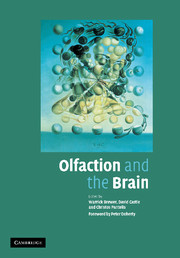Book contents
- Frontmatter
- Contents
- Foreword
- Preface
- List of Contributors
- Section I Neurology, Neurophysiology and Neuropsychology: Olfactory Clues to Brain Development and Disorder
- Section II Social Functioning: Role of Evolution, Genetics and Gender
- Section III Assessment and Disorders of Olfaction
- Index
- Plate section
Foreword
Published online by Cambridge University Press: 17 August 2009
- Frontmatter
- Contents
- Foreword
- Preface
- List of Contributors
- Section I Neurology, Neurophysiology and Neuropsychology: Olfactory Clues to Brain Development and Disorder
- Section II Social Functioning: Role of Evolution, Genetics and Gender
- Section III Assessment and Disorders of Olfaction
- Index
- Plate section
Summary
While there is still much to be discovered in many areas of biology, perhaps the greatest challenge is to understand the human brain, to illuminate the mind/brain duality. Unlike philosophy and religion, which can sometimes regress into the scholasticism that so limited human advancement and well-being through the dark ages, science is evidence-based and moves forward by exploration, hypothesis and experiment. Science depends on objective measurement. No matter how bright the individual research investigators may be, the conclusions that are reached can only be as good as the underlying observational systems. How do we measure the workings of the brain?
The analysis of brain function has, of course, been enormously enhanced in recent years by technologies like Magnetic Resonance Imaging (MRI) and the capacity to record various electrophysiological outputs. What then becomes important is the source and nature of the input stimuli that induce distinctive neural response patterns. When it comes to such access, the senses of sight, touch and smell provide, of course, primary, natural ‘windows’ to the brain. At least in the consciousness of medical scientists, smell came to the fore in late 2004 when Richard Axel and Linda Buck were awarded the Nobel Prize for Medicine, for ‘their discoveries of odorant receptors and the organization of the olfactory system’.
Though I work with immunity, the other great, complex biological system that mediates specific recognition of (and appropriate responses to) external stimuli, olfaction is an area that has long interested me.
- Type
- Chapter
- Information
- Olfaction and the Brain , pp. vii - viiiPublisher: Cambridge University PressPrint publication year: 2006

